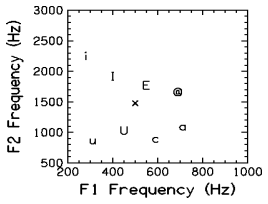space. You can
click on any vowel symbol in the figure to hear the synthetic vowel
generated by setting F1 and F2 to the coordinate values of the symbol.
These vowels are supposed to sound like:
- [i] - as in heed
- [I] - as in hid
- [E] - as in head
- [@] - as in had
- [a] - as in hod
- [c] - as in hawed
- [U] - as in hood
- [u] - as in who'd
- [x] - as in hud
The F1,F2 values for these examples were taken from the classic study
of American English vowels by Peterson and Barney (1952). A recent
replication of the Peterson and Barney
study (Hillenbrand, et al., 1995) does not completely
agree with the average values Peterson and Barney found. This is most
obviously the case for the vowels E and @. This may be because of
differences in measurement methods, or because @ vowels have shifted
slightly in the last 40 years, or perhaps other factors are
involved. Please read about this in the handout of the Hillenbrand,
et al. (1995) paper.
Task 1
Listen to each of the vowels in this figure. None sound terribly
natural, but some are better exemplars than others of the
vowel you would expect to hear. Rank order these 9 vowels from best
exemplar of category to poorest exemplar. We'll compare results in
class. (Note that ties are allowed)
Task 2
For the vowel you feel is the poorest exemplar of the set, use the simple vowel interface to experiment with
changes in F1 and F2 to make a vowel that sounds like a better
exemplar to you. Save the F1 and F2 values you used.
Task 3
These vowels should sound like they were produced by a male
talker. Use the simple vowel interface to
make vowels which sound like they were produced by a female
talker. Use 220 as the F0 value for this. Write down the F1 and F2
values you select for each vowel and we'll compare results in class.
References
Hillenbrand, J., Getty, L.A., Clark, M.J., Wheeler, k. (1995). Acoustic
characteristics of American English vowels. J. Acoust. Soc. Am.,
97, 3099-3111.
Peterson, G.E., and Barney, H.L., (1952). Control methods used in a
study of the vowels. J. Acoust. Soc. Am. 24, 175-184.
All text and graphics unless otherwise specified by H. Timothy Bunnell, Ph.D
bunnell@asel.udel.edu
Last Modified: November 28, 2015 (htb).

